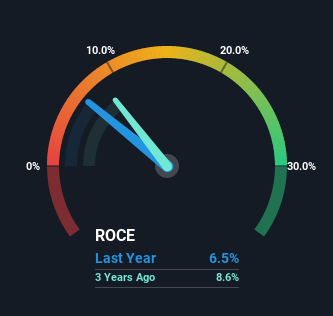- Hong Kong
- /
- Construction
- /
- SEHK:6816
Returns On Capital Signal Tricky Times Ahead For Prosper Construction Holdings (HKG:6816)

Did you know there are some financial metrics that can provide clues of a potential multi-bagger? Amongst other things, we'll want to see two things; firstly, a growing return on capital employed (ROCE) and secondly, an expansion in the company's amount of capital employed. Basically this means that a company has profitable initiatives that it can continue to reinvest in, which is a trait of a compounding machine. However, after briefly looking over the numbers, we don't think Prosper Construction Holdings (HKG:6816) has the makings of a multi-bagger going forward, but let's have a look at why that may be.
Understanding Return On Capital Employed (ROCE)
If you haven't worked with ROCE before, it measures the 'return' (pre-tax profit) a company generates from capital employed in its business. The formula for this calculation on Prosper Construction Holdings is:
Return on Capital Employed = Earnings Before Interest and Tax (EBIT) ÷ (Total Assets - Current Liabilities)
0.065 = HK$80m ÷ (HK$4.4b - HK$3.2b) (Based on the trailing twelve months to December 2021).
Thus, Prosper Construction Holdings has an ROCE of 6.5%. On its own, that's a low figure but it's around the 7.6% average generated by the Construction industry.
Check out our latest analysis for Prosper Construction Holdings

Historical performance is a great place to start when researching a stock so above you can see the gauge for Prosper Construction Holdings' ROCE against it's prior returns. If you'd like to look at how Prosper Construction Holdings has performed in the past in other metrics, you can view this free graph of past earnings, revenue and cash flow.
So How Is Prosper Construction Holdings' ROCE Trending?
When we looked at the ROCE trend at Prosper Construction Holdings, we didn't gain much confidence. Around five years ago the returns on capital were 20%, but since then they've fallen to 6.5%. Although, given both revenue and the amount of assets employed in the business have increased, it could suggest the company is investing in growth, and the extra capital has led to a short-term reduction in ROCE. If these investments prove successful, this can bode very well for long term stock performance.
While on the subject, we noticed that the ratio of current liabilities to total assets has risen to 72%, which has impacted the ROCE. If current liabilities hadn't increased as much as they did, the ROCE could actually be even lower. What this means is that in reality, a rather large portion of the business is being funded by the likes of the company's suppliers or short-term creditors, which can bring some risks of its own.
The Bottom Line
While returns have fallen for Prosper Construction Holdings in recent times, we're encouraged to see that sales are growing and that the business is reinvesting in its operations. And there could be an opportunity here if other metrics look good too, because the stock has declined 15% in the last five years. So we think it'd be worthwhile to look further into this stock given the trends look encouraging.
Since virtually every company faces some risks, it's worth knowing what they are, and we've spotted 5 warning signs for Prosper Construction Holdings (of which 3 can't be ignored!) that you should know about.
If you want to search for solid companies with great earnings, check out this free list of companies with good balance sheets and impressive returns on equity.
If you're looking to trade Prosper Construction Holdings, open an account with the lowest-cost platform trusted by professionals, Interactive Brokers.
With clients in over 200 countries and territories, and access to 160 markets, IBKR lets you trade stocks, options, futures, forex, bonds and funds from a single integrated account.
Enjoy no hidden fees, no account minimums, and FX conversion rates as low as 0.03%, far better than what most brokers offer.
Sponsored ContentNew: Manage All Your Stock Portfolios in One Place
We've created the ultimate portfolio companion for stock investors, and it's free.
• Connect an unlimited number of Portfolios and see your total in one currency
• Be alerted to new Warning Signs or Risks via email or mobile
• Track the Fair Value of your stocks
Have feedback on this article? Concerned about the content? Get in touch with us directly. Alternatively, email editorial-team (at) simplywallst.com.
This article by Simply Wall St is general in nature. We provide commentary based on historical data and analyst forecasts only using an unbiased methodology and our articles are not intended to be financial advice. It does not constitute a recommendation to buy or sell any stock, and does not take account of your objectives, or your financial situation. We aim to bring you long-term focused analysis driven by fundamental data. Note that our analysis may not factor in the latest price-sensitive company announcements or qualitative material. Simply Wall St has no position in any stocks mentioned.
About SEHK:6816
Prosper Construction Holdings
An investment holding company, provides marine construction, auxiliary marine related, and general construction contracting services.
Slightly overvalued with imperfect balance sheet.
Market Insights
Community Narratives


